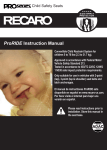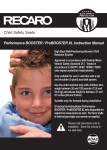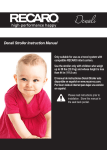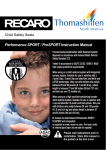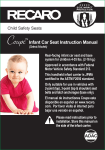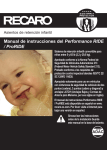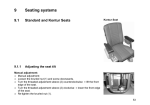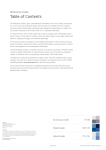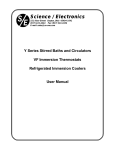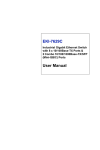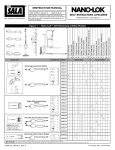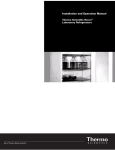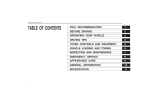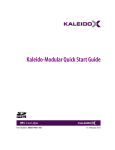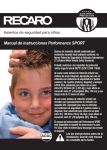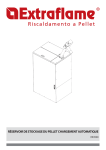Download Performance RIDE / ProRIDE Instruction Manual
Transcript
Child Safety Seats Performance RIDE / ProRIDE Instruction Manual Convertible Child Restraint System for children 5 to 65 lbs (2.3 to 29.5 kg). Approved in accordance with Federal Motor Vehicle Safety Standard 213. Tested in accordance to ISO/TC 22/SC 12/WG 1 N538 side impact protection requirements. Only suitable for use in vehicles with 2-point (lap), 3-point (lap & shoulder) seat belts and latch anchorages. El manual de instructiones Performance RIDE / ProRIDE esta disponible en español en www. recaro-cs.com. Por favor visite el internet para bajar una versión en español. Please read instructions prior to installation. Store this manual in the seat base. B Contents Section 1: Safety Warnings.......................................... p. 4-5 Section 2: General Information.........................................p. 6 Section 3: Register Your New Child Restraint..................p. 7 Section 4: Getting to Know Your Child Restraint........ p. 8-13 Section 5: Securing the Child in the Child Restraint......p. 14-16 Section 6: Adjusting the Harness System to Fit Your Child.............................................p. 17 Section 7: Choosing a Seating Location in Your Vehicle......................................... p. 18-19 Section 8: Learning About Your Vehicle Safety Systems....................................... p. 20-22 Section 9: Installing the Child Restraint Rear-Facing in Your Vehicle.................... p. 23-35 Section 10:Installing the Child Restraint Forward-Facing in Your Vehicle.............. p. 36-46 Section 11:Certification...................................................p. 47 Section 12:Use in Aircraft................................................p. 47 Section 13:Care and Maintenance..................................p. 48 Section 14:Trim Cover Removal and Installation............................................... p. 49-56 Section 15:Trouble Shooting.....................................p. 57–58 Section 16:Replacement Parts........................................p. 59 Section 17:Warranty.................................................. p. 60-61 Section 18:Additional Contact Information......................p. 62 Section 19:Glossary..................................................p. 63–65 1 Dear Parents, Welcome to the RECARO family of high quality child safety products and thank you for purchasing your new RECARO Child Restraint System. RECARO has over 100 years experience in the design and manufacture of premium automotive products. To assure all products RECARO manufactures are worthy of the name, we’ve subjected them to a comprehensive development program complying with American FMVSS 213 safety standards. RECARO is also ISO 9001 certified which helps assure the most comprehensive product development system available. Although each RECARO child restraint system is equipped with state-of-the-art safety features such as Side Impact Protection (SIP), it is not a guarantee that this child restraint will prevent injury or death. However, if you stress careful driving and proper use of your child restraint, it can lower the risk of injury or death. Therefore, please make sure to carefully review all information in this instruction manual to properly restrain your child. Also, before using your new child restraint for the first time, please review all components carefully to make sure nothing has been damaged during shipping. Failure to follow these instructions and the labels on the seat can result in serious injury or even death. The RECARO child seat you have purchased is a high quality product. 2 Its different settings and its stable and ergonomic design ensure that the RECARO child seat is a safe and comfortable place for your child to sit when traveling in your car. However, before you use it, you need to adjust it to your child’s size and then install it carefully so that the seat will perform as required. These instructions will help you do this, so please read them carefully. Remember, parents are a child’s best examples. Be sure to ALWAYS buckle your seat belt and your children will be much more likely to do the same. Thank you again for choosing RECARO and enjoy your child restraint! If you have any questions or need assistance of any kind please contact us at: RECARO Child Safety, LLC 1600 Harmon Road Auburn Hills, MI 48326 Tel: 1-888-9RECARO Internet: www.recaro-cs.com E-mail: [email protected] El manual de instructiones Performance RIDE / ProRIDE esta disponible en español en www.recaro-cs.com. Por favor visite el internet para bajar una versión en español. Yours sincerely, The RECARO Child Safety Team 3 Section 1: Safety Warnings Safety Warnings or SERIOUS INJURY WARNING! DEATH can occur • Do NOT place a child restraint in the front seat of a vehicle with a passenger air bag. The back seat is the safest place for children under 12 years of age. • According to accident statistics, children are safer when properly restrained in the rear seating positions than in the front seating positions. • Use only with children who weigh between 5 and 65 pounds (2.3 and 29.5 Kg) and whose height is 49 inches (125 cm) or less. Rear-facing 5 - 40 pounds (2.3 and 15.9 kg) and Forward-facing 20 - 65 pounds (9.1 and 29.5 kg) and at least 1 year of age. Do NOT use for a child who weighs more than 65 pounds (29.5 kg) • Discontinue use of your child restraint that is older than six (6) years or has been in a severe crash to prevent injury due to deterioration or hidden damage. See “manufactured in date” located on a sticker on the Performance RIDE / ProRIDE. • Secure this child restraint with the vehicle’s child restraint LATCH anchorage system if available or with a vehicle belt. • Do not use the lower anchors of the child restraint anchorage system (LATCH system) to attach this child restraint when restraining a child weighing more than 45 pounds (20.4 kg).” • Secure the top anchorage strap provided with this child restraint. • Snugly adjust the belts provided around your child. • A snug strap should NOT allow any slack. It lies in a relatively straight line without sagging. It does NOT press on the child’s flesh or push the child’s body into an unnatural position. • Do NOT use this child restraint system until you have read and understood the instructions in this manual and in your vehicle owner’s manual. Do NOT let others install or use this child restraint system unless they understand how to use it. 4 • Do NOT make any technical modification to the child restraint system and use it only as outlined in these instructions. Otherwise, the safety function of the seat will be reduced or completely voided. • Before each use, inspect the child restraint. Make sure nothing on the child restraint is damaged, loose or broken. If anything on the child restraint appears damaged, loose or broken, do NOT use the restraint. • Failure to follow warnings provided on the child restraint labels and stickers could cause serious injury or death. • The child restraint should be securely belted to the vehicle, even when it is not occupied, since in a crash an unsecured child restraint system may injure other occupants. • Placing your child in a hot child restraint may result in burns. • Do NOT add accessories, toys, padding or other items to the child restraint unless provided by RECARO. • This child restraint must NOT be used in the home, boats or other non-certified applications. • If the child restraint has been in a crash or vehicle accident, it must be replaced; do NOT use the child restraint again. A crash can cause unseen damage and using the child restraint again can cause serious injury or death. •NEVER leave a child unattended even when sleeping. • NEVER allow a child to play with the child restraint; it is NOT a toy. • There is no guarantee that the child restraint will prevent injury or death in a particular crash. However, if you stress careful driving and proper use of the child restraint, it can lower the risk of injury or death in most crashes. • Do NOT lubricate buckles, fasteners or any part of the child restraint. • NEVER use a used child seat unless you know its complete history. 5 SAFETY WARNINGS or SERIOUS INJURY WARNING! DEATH can occur Section 2: General Information Infant Insert Following Section 5: Securing the Child in the Child Restraint, pg. 14, you may find that the harness does not fit snug against your child. If this is the case, the RECARO infant insert may be required. Please call 1-888-9RECARO and RECARO will ship you an infant insert and instructions. Locking Clip Following Section 9: Installing the child restraint Rear-Facing in Your Vehicle, pg. 35, Non-Locking ELR Lap-Shoulder Belt installation, you may find that you cannot install without a universal locking clip. Please call 1-888-9RECARO and RECARO will ship you a locking clip and instructions. Extreme Weather General information When it is HOT, RECARO recommends the following tips to reduce possible injury or discomfort to your child: • Park your vehicle in the shade to help keep the restraint cooler. • Cover the child restraint with a sheet or blanket when not in use. • ALWAYS check surface temperatures of the child restraint before placing a child in it. When it is COLD, RECARO recommends the following tips to reduce possible injury or discomfort to your child: • Remove the child’s bulky clothing before restraining the child. This will help belts and other safety features function properly. • After restraining the child in the seat, cover the child and the restraint system with a blanket or their jacket to maintain warmth and comfort of the child. NEVER, EVER leave your child unattended in your vehicle, no matter how long or even if the windows are left open. NHTSA studies show that heat stroke is the leading cause of non-crash vehicle deaths for children. 6 Child restraints could be recalled for safety reasons. You must register this restraint to be reached in a recall. Send your name, address, email address if available, and the restraint’s model number, serial number and manufacturing date to: . RECARO Child Safety, LLC 1600 Harmon Road Auburn Hills, MI 48326 or call: 1-888-9RECARO ) 8 or register online at: http://www.registry.recaro-cs.com For recall information, call the U.S. Government’s Vehicle Safety Hotline at 1-888-327-4236 (TTY: 1-800-424-9153) or go to http://www.NHTSA.gov. ALL information provided to RECARO on the registration card or on the online registry will NOT be sold, distributed, or used for any purposes other than to contact you in the event of a recall. 7 REGISTER YOUR NEW Child Restraint Section 3: Register Your New Child Restraint GETTING TO KNOW YOUR Child Restraint Section 4: Getting to Know Your Child Restraint This child restraint is known as a convertible child restraint because it converts from a Rear-Facing into a Forward-Facing restraint system as your child grows. It is important to know the difference between these two use modes, be able to choose which mode is appropriate for your child, and be able to choose which sections of this instruction manual apply to the mode that you desire. To facilitate choosing the right set of the instructions for the mode that you desire, look for color codes on the sides of the pages in this instruction manual. Rear-Facing instructions are indicated in PINK, and Forward-Facing instructions are indicated in BLUE. Note that general information and information applying to both user modes is not color-coded. NEVER use the child restraint system for a child who is not the recommended height, weight or age recommended in this instruction manual. The American Academy of Pediatrics and NHTSA recommend keeping children rearward facing up to age 2. RECARO advocates using a convertible child restraint up to maximum rearward facing weight and height. 8 The child restraint is NOT appropriate for all children. You must confirm the child meets ALL of the height, weight and other fit requirements. Please measure and weigh the child to verify the Performance RIDE / ProRIDE is the correct seat for them. NOTE: If the child does NOT meet ANY of the height, weight or other fit requirements for this child restraint, the child CANNOT use it. If that is the case, please see the other fine child restraint systems that are offered by RECARO. A child CAN use the child restraint in the Rear-Facing position ONLY if: Rear-Facing position •The child’s weight is between 5 and 40 pounds (2.3 kg and 15.9 kg). •The harness CAN be positioned AT or BELOW the child’s shoulders, when the child is seated. •The child’s seated height* is LESS than 22.5 inches (57cm). •When sitting in the child restraint the top of the child’s head is NOT closer than 1 inch (2.5cm) from the top edge of the seat back. *NOTE: A child’s seated height measures the distance from the top of their head to the bottom of their tailbone, when they are sitting. 9 GETTING TO KNOW YOUR Child Restraint or SERIOUS INJURY WARNING! DEATH can occur or SERIOUS INJURY WARNING! DEATH can occur A child CAN use this child restraint in the Forward-Facing position ONLY if: GETTING TO KNOW YOUR Child Restraint Forward-Facing position • The child is at least 12 months of age. •The child’s weight is between 20 and 65 pounds (9.1kg and 29.5 kg). •The harness CAN be positioned AT or ABOVE the child’s shoulders, when the child is seated in the Performance RIDE / ProRIDE . •The child’s standing height* is LESS than 49 inches (125 cm). •When the child is sitting and the head restraint is in the highest position, the top of the child’s ears must be BELOW the top of the head restraint. •If ANY portion of the child’s head exceeds the top edge of the child restraint, there must be a vehicle headrest support. NOTE: A child’s standing height measures the distance from the top of their head to the bottom of their feet, when they are standing. Safety Stripe System TM (Select Models) Your child restraint is equipped with the easy-to-use RECARO Safety Stripe SystemTM. You will notice that your harness has a white stripe on the outside edges. This added safety feature will allow you to ensure that your harness is not twisted. The white stripe should always remain at the outside edge of the harness above the lower buckle. If it is not, please loosen your harness system and remove any twist prior to use. 10 Side Impact Protection It is important to become familiar with the features of your child restraint system. These diagrams help you identify key features. Head Integrated 5-Point Restraint Trim Cover & Harness Comfort Padding Chest Clip Latch Plates (2) Harness Pockets (2) Buckle Armrests (2) Seat Base Level Line Seat Bottom 11 Recline Adjuster Adjuster Lever Cover Harness Adjuster Strap GETTING TO KNOW YOUR Child Restraint Child Restraint Features: Child Restraint Features: GETTING TO KNOW YOUR Child Restraint It is important to become familiar with the features of your child restraint system. These diagrams help you identify key features. Harness System Adjustment Knobs (2) Top Tether Storage Pouch Forward-Facing Vehicle Belt Path and Belt Lock-off Harness Straps (2) Harness Connector LATCH Adjusters (2) Rear-Facing Vehicle Belt Path LATCH Connectors * (2) LATCH Strap Tether Strap Tether Hook *Stored in slots on the rear of the base. 12 Standard Harness System with Shoulder Pads (2) Performance RIDE HERO Harness System Cup Holder NOTE: Only provided with Performance RIDE 13 GETTING TO KNOW YOUR Child Restraint ProRIDE securing the child in the Child Restraint Section 5: Securing the Child in the Child Restraint 1 1. Loosen the harness system. Press the adjuster lever located under the adjuster flap and pull the shoulder straps forward. 2 2. Open the chest clip by squeezing tabs and separating. 3 4 3. Open buckle by pressing red button. Place harness straps to the side or place chest clip into harness pocket to hold. 4. Seat the child in the child restraint with his/her bottom fully into the seat. Position the harness straps around the child and fasten both latch plates into the buckle. 14 5. Fasten chest clip. 6. Pull up on each shoulder strap to tighten the lower section of the harness. 6 7 7. Tighten harness by pulling adjuster strap straight out through the adjuster flap. The harness webbing should be snug around the child in both the lap and shoulder sections. Slide chest clip so it is at the child’s armpit level. 8. The harness is tight enough when you cannot pinch a loop of webbing. 8 9. If you find the harness is not tight fitting, an infant insert may be required. Please contact 1-888-9RECARO and RECARO will ship you an infant insert and instructions. 15 SECURING THE CHILD IN THE Child Restraint 5 securing the child in the Child Restraint Rear-Facing: Check the harness height on the child’s shoulders. •The harness is positioned AT or BELOW the child’s shoulders, when the child is seated. •Adjust the harness for the child BEFORE driving. •The child’s seated height* is LESS than 22.5 inches (57cm). •When sitting in the child restraint the top of the child’s head is NOT closer than 1 inch (2.5cm) from the top edge of the seat back. *NOTE: A child’s seated height measures the distance from the top of their head to the bottom of their tailbone, when they are sitting. Forward-Facing: Check the harness height on the child’s shoulders. •The harness is positioned AT or ABOVE the child’s shoulders, when the child is seated. •Adjust the harness for the child BEFORE driving. •The child’s standing height* is LESS than 49 inches (125 cm). •When sitting in the child restraint and the head restraint is in the highest position, the top of the child’s ears must be BELOW the top of the head restraint. •If ANY portion of the child’s head exceeds the top edge of the child restraint, there must be a vehicle headrest support. *NOTE: A child’s standing height measures the distance from the top of their head to the bottom of their feet, when they are standing. 16 Place your child in the child restraint prior to installing in the vehicle and determine if the shoulder strap height needs to be adjusted. • When using the Rear-Facing, the shoulder straps must be located AT or BELOW the child’s shoulders. • When using the Forward-Facing, the shoulder straps must be located AT or ABOVE the child’s shoulders. 1. Loosen the harness system. Press the adjuster lever located under the adjuster flap in the trim cover and pull the shoulder straps forward. 1 2a. Rotate the harness system adjustment knobs to raise the shoulder straps or to lower the shoulder straps. 2a 2b. Refer to the labels, near the harness system adjustment knobs. 2b Headrest Adjustment To Lower: Rotate Knob Clockwise To Raise: Rotate Knob Counter-Clockwise NOTE: The head restraint will move up and down. DO NOT over rotate the knobs. 3. Pull shoulder straps to ensure the system is secure. 17 ADJUSTING THE HARNESS SYSTEM TO FIT YOUR CHILD Section 6: Adjusting the Harness System to Fit Your Child CHOOSING A SEATING LOCATION IN YOUR VEHICLE Section 7: Choosing a Seating Location in Your Vehicle Forward-Facing vehicle seats must ALWAYS be used with this child restraint. If your vehicle does not have rear seats, consult your vehicle owner’s manual to help identify safety features in your vehicle or contact the vehicle manufacturer. Do NOT install this child restraint into any of the following types of seating positions: • NEVER install on a rear-facing vehicle seat. • NEVER install in the rear seat of small extended cab pickup. • NEVER install on a side-facing vehicle seat. If the vehicle backrest angle is adjustable, adjust vehicle’s backrest into the upright position. Be sure this area is flat and clear of objects that might get in the way of installing the child restraint. 18 • Do NOT place rear-facing child seat on front seat with air bag. The high pressure deployment of the airbag can cause serious injury or death to a child. If your vehicle is equipped with front passenger airbags, consult your vehicle owner’s manual for installation instructions for child restraints. If your vehicle does not have rear seats, consult your vehicle’s owner’s manual to help identify safety features in your vehicle or contact the vehicle manufacturer. RECARO and the U.S. Department of Transportation warn that children age 12 and under MUST ride in the rear seat away from front airbags. Restraint systems should be securely belted to the vehicle, even when they are not occupied, since in a crash an unsecured child restraint system may injure other occupants or store it somewhere outside the passenger cabin so that it cannot injure anyone while the vehicle is in motion. RECARO recommends storing the child restraint in a cool and dry location. 19 CHOOSING A SEATING LOCATION IN YOUR VEHICLE or SERIOUS INJURY WARNING! DEATH can occur LEARNING ABOUT YOUR VEHICLE SAFETY SYSTEMS Section 8: Learning About Your Vehicle Safety Systems It is important to become familiar with the features of your vehicle so that your child rides as safely as possible. Read the vehicle owner’s manual to learn about the safety features and adjustments available for safe travel. Below is a diagram that helps you to identify key features. Not all vehicles will have all features described here. Airbags Top Tether Anchorage Lower Latch Anchorage Seat Belts Some vehicles may have inflatable seat belts. As this is new technology, please refer to www.recaro-cs.com for updates. 20 Because the design and operation of vehicle belts vary, make sure to observe the following guidelines: • Do NOT use motorized passive restraint shoulder belt systems. • Do NOT use passive restraints lap or shoulder belt mounted on a door. • Do NOT use vehicle lap and shoulder belt systems that have independent retractors for the lap and shoulder portion of the vehicle seat belt system. NOTE: If you have a seat belt system described above, check your vehicle owner’s manual for advice on where and how to install a child restraint. Your vehicle dealer may have a replacement lap belt that when installed will hold the child restraint tightly. 21 LEARNING ABOUT YOUR VEHICLE SAFETY SYSTEMS or SERIOUS INJURY WARNING! DEATH can occur LEARNING ABOUT YOUR VEHICLE SAFETY SYSTEMS Vehicle Seat Belt Systems Important! Check to be sure which type of seat belt system you have in the chart below. Some vehicles have more than one type of belt system depending on the seating position. The center rear position may have a lap only belt while the side seating locations may have a lap/shoulder system. If you are not sure which system you have, check your vehicle owner’s manual or contact your vehicle dealer or manufacturer. Types of Seat Belt Systems Rear Facing - See page 27 Locking Lap Belt Front Facing - See page 41 Locking Lap Shoulder Belt Rear Facing - See page 31 Front Facing - See page 43 Non Locking ELR Lap Shoulder Belt Rear Facing - See page 35 Front Facing - See page 45 22 or SERIOUS INJURY WARNING! DEATH can occur • ALWAYS use in reclined position when installed Rear-Facing. If your vehicle has lower anchors, the LATCH connector system can be used. Check your vehicle owner’s manual to determine if lower anchors are available and applicable vehicle seating positions. If lower anchors are not available the vehicle seat belt must be used. NOTE: Your child restraint seat is shipped with latches installed for the Forward-Facing mode. 1 2 1. Adjust the child restraint into the recline position by pulling the recline adjust handle and rotating the seat back. Rotate to locked position. 2. Locate the latch LATCH connectors at the rear of the base; press the red buttons and remove the connectors from the storage slots. 23 - LATCH Installation LATCH Installation – Rear-Facing REAR-FACING Section 9: Installing the Child Restraint Rear-Facing in Your Vehicle 3 REAR-FACING - LATCH Installation 4 5a 5b 3. Lengthen the latch strap by pressing the latch adjuster release button and pull webbing to full length. 4. Route LATCH connector through so both connectors sit on the side where the latch is attached to the shell. 5a.Lift trim cover at the front and route the latch strap through the rear- facing belt path (circled in red). 5b.Make sure the arrows molded on the LATCH connectors are facing up and replace the trim cover. 24 8 7. While pressing down on the armrest on the same side as the adjuster, pull the loop on the latch strap to tighten. Repeat as needed until the child restraint cannot be moved more than 1 inch (2.5 cm) in any direction at the belt path. 8. The level line indicator on the seat base should be level with the ground when the vehicle is parked. The backrest should be at approximately a 45-degree angle. 25 - LATCH Installation 7 6. Place the child restraint on the vehicle seat facing rearward. Attach each LATCH connector to the lower anchor in the vehicle. REAR-FACING 6 9 9. If the child restraint is too upright, loosen both LATCH connectors and place a tightly rolled towel or foam pool noodle under the base below where the child’s feet will be located. NOTE: Do NOT place anything under the base, except as shown in Fig. 9. REAR-FACING - LATCH Installation 10. Follow steps 1-8 to secure the child restraint after adjusting the angle. 11. After adjusting the recline angle, check that the child restraint is tight and properly secured. The child restraint should not move more than 1 inch (2.5 cm) in any direction at the belt path. 12. To remove the LATCH connectors from the vehicle, first loosen both adjusters by pressing the adjuster button and lengthening the straps (see Fig. 3). Press the red buttons on the LATCH connectors and remove from vehicle lower anchors (see Fig. 6). 13. Replace the LATCH connectors into the storage slots at rear of base. 26 If your vehicle has a locking lap belt, use Locking Lap Belt Installation instructions. or SERIOUS INJURY WARNING! DEATH can occur • Always use in reclined position when installed rear-facing. 1 2 1. Adjust into the recline position by pulling the recline adjust handle and rotating the seat back. Rotate to locked position. 2. Lift the trim cover at the front and locate the rear-facing belt path (circled in red). 27 -Locking Lap Belt Installation Many vehicles have lap only belt systems in the center rear seating positions. Most of these systems use a locking lap belt which can easily secure a child restraint. Check your vehicle owner’s manual to determine which type of seat belt system is in each seating location. There may be a label located on the seat belt with instructions for use with a child restraint. REAR-FACING Locking Lap Belt Installation – Rear-Facing 3 5 4. Route the seat belt through the rear-facing belt path. Make certain the vehicle belt is routed under the crotch belt. 5. Make sure the seat belt is not twisted, then buckle seat belt. Replace the trim over the front edge of the seat bottom. REAR-FACING - Locking Lap Belt Installation 4 3. Place the child restraint on the vehicle seat facing rearward. Slide latch plate to the end of seat belt webbing. 28 7. The level line indicator on the seat base should be level with the ground when the vehicle is parked. The backrest should be at approximately a 45-degree angle. 29 - Locking Lap Belt Installation 7 6. While pressing on the armrest on the same side as the vehicle buckle, pull the end of the seat belt strap to tighten. Repeat as needed until the child restraint cannot be moved more than one inch (2.5 cm) in any direction at the belt path. REAR-FACING 6 8 8. If the child restraint is too upright, loosen the seat belt and place a tightly rolled towel or foam pool noodle under the base below where the child’s feet will be located. 9. Follow Steps 1–7 to secure the child restraint after adjusting the angle. 10. After adjusting the recline angle, check that the child restraint is tight and properly secured. The child restraint should not move more than 1 inch (2.5 cm) in any direction at the belt path. REAR-FACING - Locking Lap Belt Installation NOTE: Do NOT place anything under the base, except as shown in Fig 8. 30 If your vehicle has a switchable retractor or locking latch plates, use Locking LapShoulder Belt Installation instructions. or SERIOUS INJURY WARNING! DEATH can occur • Always use in reclined position when installed rear-facing. 1 1. Adjust into the recline position by pulling the recline adjust handle and rotating the seat back. Rotate to locked position. 31 - Locking Lap -Shoulder Belt Installation Many vehicles have lap-shoulder belt systems which remain loose for adult use and can be locked for use with a child restraint. Check your vehicle owner’s manual to determine which type of seat belt system is in each seating location. There may be a label located on the door side of the seat belt with instructions for use with a child restraint. REAR-FACING Locking Lap-Shoulder Belt Installation – Rear-Facing 3 4 2. Lift the trim cover at the front and locate the rear-facing belt path (circled in red). 3. Pull the seat belt out fully holding lap and shoulder sections together and route through the rear-facing belt path. Make certain the vehicle belt is routed under the crotch belt. 4. Make sure the seat belt is not twisted, then buckle seat belt. Replace the trim over the front edge of the seat bottom. REAR-FACING - Locking Lap-Shoulder Belt Installation 2 32 6. The level line indicator on the seat base should be level with the ground when the vehicle is parked. The backrest should be at approximately a 45-degree angle. 33 - Locking Lap-Shoulder Belt Installation 6 5. While pressing on one armrest, remove slack from shoulder belt. To help securely tighten, press down on the other armrest and remove any remaining slack from seat belt. Repeat as needed until the child restraint cannot be moved more than one inch (2.5 cm) in any direction at the belt path. REAR-FACING 5 7. If the child restraint is too upright, loosen the seat belt and place a tightly rolled towel or foam pool noodle under the base below where the child’s feet will be located. NOTE: Do NOT place anything under the base, except as shown in Fig 7. 8. Follow Steps 1–8 to secure the child restraint after adjusting the angle. 9. After adjusting the recline angle, check that the child restraint is tight and properly secured. The child restraint should not move more than 1 inch (2.5 cm) in any direction at the belt path. 10. Ensure that vehicle belt is locked. REAR-FACING - Locking Lap-Shoulder Belt Installation 7 34 If your vehicle has a non-locking lap-shoulder belt system, use NonLocking ELR Lap-Shoulder Belt Installation instructions. If you have this seat belt configuration you will require a locking clip. Please contact 1-888-9RECARO and RECARO will ship you a locking clip and instructions. or SERIOUS INJURY WARNING! DEATH can occur • Always use in reclined position when installed rear-facing. NOTE: Locking clip required. 35 - Non-Locking ELR Lap-Shoulder Belt Installation Some older vehicles (typically pre-1996 model year) have lap-shoulder belt systems which remain loose and cannot be locked for use with a child restraint unless a separate locking clip is used. These systems use emergency locking retractors which lock only during a sudden stop or crash. Check your vehicle owner’s manual to determine which type of seat belt system is in each seating location. There may be a label located on the door side of the seat belt with instructions for use with a child restraint. REAR-FACING Non-Locking ELR Lap-Shoulder Belt Installation – Rear-Facing Section 10: Installing the Child Restraint Forward-Facing in Your Vehicle FORWARD-FACING - LATCH Installation or SERIOUS INJURY WARNING! DEATH can occur If your vehicle has lower anchors, the LATCH system can be used. Your vehicle may also have a top tether anchorage located behind the vehicle seat. Refer to your vehicle owner’s manual to determine if lower anchors and top tether anchors are available and for which seating positions. If lower anchors are not available the vehicle seat belt must be used. The top tether can be used with the vehicle seat belt or LATCH. Additionally, LATCH and top tether anchors are designed to a maximum limit which can vary by vehicle. Due to this variation, RECARO requires use of the vehicle seat belt for any child weighing more than 45 lbs (20.4 kg). Your vehicle will also have a top tether anchorage located behind the vehicle seat. Refer to your vehicle owner’s manual if it is difficult to find. This can also vary by vehicle. Do NOT use a cargo tie down for the top tether attachment. NOTE: The child restraint seat is shipped with the LATCH strap installed in the forward-facing mode. If you are switching from rear-facing, you will need to reroute the LATCH strap. •Use ONLY the fully up-right position when installed forward-facing. 36 2 4a 2. Locate the latch LATCH connectors at the rear of the base, press the red buttons and remove the connectors from the storage slots. 3. Lengthen the latch strap by pressing each adjuster release button and pull to full length. 4a. Route the LATCH connector through the forward-facing vehicle seat belt path. 37 - LATCH Installation 3 1. Adjust into the upright position by pulling the recline adjust handle and rotating the seat back upright. Check to be sure it locks into position. FORWARD-FACING 1 4b FORWARD-FACING - LATCH Installation 5 6 4b. Make sure the arrows on the LATCH connectors face up and the strap is not twisted. 5. Before attaching the LATCH connectors, locate the top tether anchor behind the seating position. Refer to your vehicle owner’s manual if it is difficult to find. If your vehicle has top tether anchors, remove the restraint top tether from its storage pouch and place it over the vehicle seat back. 6. Place the child restraint on the vehicle seat facing forward. Attach each LATCH connector to the anchors in the vehicle. 38 7. While pressing down on the armrest on the same side as the adjuster, pull the loop on the latch strap to tighten. Repeat as needed until the child restraint cannot be moved more than one inch (2.5 cm) in any direction at the belt path. 9 8. Connect the top tether hook to the anchor. NOTE: Do NOT use a cargo tie down for tether attachment. Check your vehicle owner’s manual if you are not sure. 9. Snugly tighten the top tether by pulling the free end of the tether strap while pressing the top of the child restraint back into the vehicle seat. 39 - LATCH Installation 8 FORWARD-FACING 7 10. Check the tightness of the latch strap and retighten if needed. This strap may become loose when the top tether strap is tightened. Recheck that both the latch strap and the top tether strap are tight and properly secured. 12. To remove the top tether, press the release button and pull the strap. It may be necessary to press the top of the child restraint into the vehicle seat back to loosen the tether adjuster. Unhook the top tether anchor from the vehicle attachment. 13. Fold the top tether strap and place it in the storage pouch when not in use. Place the LATCH connectors in their storage locations when not in use. FORWARD-FACING - LATCH Installation 11. To remove the LATCH connectors from the vehicle, first loosen the adjuster by pressing the adjuster button and lengthening the strap. Press the red buttons on the LATCH connectors and remove from vehicle lower anchors. 40 Many vehicles have lap only belt systems in the center rear seating positions. Most of these systems use a locking lap belt which can easily secure a child restraint. Check your vehicle owner’s manual to determine which type of seat belt system is in each seating location. There may be a label located on the door side of the seat belt with instructions for use with a child restraint. or SERIOUS INJURY WARNING! DEATH can occur •Use ONLY the fully up-right position when installed forward-facing. 1. Adjust the child restraint into 1 the upright angle position by pulling the recline adjust handle and rotating the seat back upright. Check to be sure it locks into position. 2 2. Place the child restraint on the vehicle seat facing forward. Slide latch plate to end of seat belt webbing. 41 - Locking Lap Belt Installation If your vehicle has a locking lap belt, use Locking Lap Belt Installation instructions. FORWARD-FACING Locking Lap Belt Installation – Forward-Facing FORWARD-FACING - Locking Lap Belt Installation 3 4 5 3. Making sure the seat belt is not twisted, route the seat belt through the forwardfacing belt path, then buckle seat belt. 4. While pressing down on the armrest on the same side as the vehicle buckle, pull the end of the strap to tighten. Repeat as needed until the child restraint cannot be moved more than one inch (2.5 cm) in any direction at the belt path. 5. If your vehicle has a top tether anchors, attach and tighten the top tether as shown on page 39. 42 Many vehicles have lap-shoulder belt systems which remain loose for adult use and can be locked for use with a child restraint. Check your vehicle owner’s manual to determine which type of seat belt system is in each seating location. There may be a label located on the door side of the seat belt with instructions for use with a child restraint. or SERIOUS INJURY WARNING! DEATH can occur • Use ONLY the fully up-right position when installed forward-facing. 1 2 1. Adjust the child restraint into the upright angle position by pulling the recline adjust handle and rotating the seat back upright. Check to be sure it locks into position. 2. Place the child restraint on the vehicle seat facing forward. Fully extend the seat belt while holding lap and shoulder sections together. 43 - Locking Lap-Shoulder Belt Installation If your vehicle has a switchable retractor or locking latch plates, use Locking LapShoulder Belt Installation instructions. FORWARD-FACING Locking Lap-Shoulder Belt Installation – Forward-Facing FORWARD-FACING - Locking Lap-Shoulder Belt Installation 3 3. Making sure the seat belt is not twisted, route the seat belt through the forward-facing belt path, then buckle seat belt. 4. Open the belt lock off and route the shoulder section of the seat belt up into the slot. 4 5. While pressing on one armrest of the child restraint, remove slack from shoulder belt. To help securely tighten, press down on the other armrest and remove any remaining slack from the seat belt. Repeat as needed until the child restraint cannot be moved more than one inch (2.5 cm) in any direction in the belt path. 5 6. Close the belt lock off over the shoulder belt by pressing the arm down onto the webbing and close the handle. 6 7. If your vehicle has a top tether anchor, attach and tighten the top tether as shown on page 39. 44 If your vehicle has a non-locking lap-shoulder belt system, use Non-Locking ELR Lap-Shoulder Belt Installation instructions. or SERIOUS INJURY WARNING! DEATH can occur •Use ONLY the fully up-right position when installed forward-facing. 1. Adjust the child restraint into the 1 upright angle position by pulling the recline adjust handle and rotating the seat back upright. Check to be sure it locks into position. 2 2. Place the child restraint on the vehicle seat facing forward. Fully extend the seat belt while holding the lap and shoulder sections together. 45 - Non-Locking ELR Lap-Shoulder Belt Installation Some older vehicles (typically pre-1996 model year) have lapshoulder belt systems which remain loose and cannot be locked for use with a child restraint unless a separate locking system is used. These systems use emergency locking retractors (ELR) which lock only during a sudden stop or crash. Check your vehicle owner’s manual to determine which type of seat belt system is in each seating location. There may be a label located on the door side of the seat belt with instructions for use with a child restraint. FORWARD-FACING Non-Locking ELR Lap-Shoulder Belt Installation – Forward-Facing - Non-Locking ELR Lap-Shoulder Belt Installation FORWARD-FACING 3 3. Making sure the seat belt is not twisted, route the seat belt through the forward-facing belt path, then buckle seat belt. 4. Open the belt lock off and route the shoulder section of the seat belt up into the slot. 4 5. While pressing on one armrest of the child restraint, remove slack from seat belt. To help securely tighten the child restraint, press down on the other armrest and remove any remaining slack from the seat belt. Repeat as needed until the child restraint cannot be moved more than one inch (2.5 cm) in any direction on the belt path. 5 6. Close the belt lock off over the shoulder belt by pressing the arm down onto the webbing and close the handle. 6 7. If your vehicle has a top tether anchor, attach and tighten the top tether as shown on page 39. NOTE: You must use the belt lock off with this belt configuration. 46 This child restraint conforms to all applicable Federal Motor Vehicle Safety Standards. Section 12: Use in Aircraft The Performance RIDE / ProRIDE is certified for use in aircraft both rear-facing and forward-facing. The aircraft seat belt (which is not a LATCH system) must be used since lower anchors are not available on airplanes. Most airlines will allow child restraint use if it is labeled as certified for use on aircraft. Check with the airline to confirm seating is available for use with a child restraint before booking flights. At the armrest height of the aircraft seat, the child restraint is 14.5 in (36.8 cm) wide. Use this information when talking with the airline to ensure the child restraint will fit in the designated seating location. Rear-Facing Installation: Secure rear-facing as shown on pages 27-30, “Locking Lap Belt Installation – Rear-Facing.” Forward-Facing Installation: Secure forward-facing as shown on pages 41-42, “Locking Lap Belt Installation – Forward-Facing.” Place in the window seat to avoid blocking the aisle. 47 CERTIFICATION / USE IN AIRCRAFT Section 11: Certification CARE AND MAINTENANCE Section 13: Care and Maintenance This child restraint has been engineered for long life and trouble-free usage. The fabric has been designed to resist stains and soiling. With proper care and maintenance, this premium fabric will retain its beauty for years to come. To clean the trim cover “on the go”, follow these easy steps: • Remove excess soiling immediately. • Blot area with dry cloth. • To remove remaining stain, spray a light mist of soap solution and rub gently in a circular motion with a clean cloth or soft toothbrush so not to damage the fabric. • Pat dry with cloth. • When dry, use a soft brush to regain fabric’s smooth feel. To clean the trim cover at home, follow these steps: • Remove the trim cover as explained in Section 14: “Trim Cover Removal and Reinstallation.” • HAND WASH using cold water and mild soap. • Line dry to avoid shrinkage of the trim cover. • Do NOT bleach, machine wash, or machine dry. To clean the child restraint’s plastic structure, follow these tips: • Clean by hand with a sponge or soft cloth using warm water and mild soap. • Dry the structure off thoroughly with a soft towel. NOTE: • Heavily soiled areas can be spot-treated using non-solvent commercial cleaners. Use only water soluble cleaning agents. • NEVER use solutions that contain a petroleum or alcohol base. Where light creases occur, they may be removed by light steaming (an ordinary tea kettle will do). Brush the area with a soft brush. • Though RECARO tests many cleaning solutions, we cannot test them all—we suggest you ALWAYS test in a discrete area first to ensure that the cleaner does not damage the fabric. 48 Trim Cover Removal 1 2 3 1. Press the adjuster lever, located under the adjuster flap, and pull the shoulder straps forward to loosen the harness system. 2. Open the chest clip by squeezing the tabs and separating. 3. Release the harness straps from the buckle by pressing the red button. 49 TRIM COVER REMOVAL Section 14: Trim Cover Removal / Installation 4 TRIM COVER REMOVAL 5a 5b 4. Holding the harness connector bracket in one hand, remove the shoulder straps by sliding the loops (one at a time) to one side so that the edge can be guided out of the slot in the bracket. 5a.ProRIDE with Standard Harness System – Pull the straps out of the child restraint from the front pulling above the harness pads. 5b.Performance RIDE with HERO Harness System – Pull the straps out of the child restraint from the front pulling below the HERO. 50 • Do NOT remove the latch plates, chest clip or harness strap pad components from the shoulder straps! 6 7 6. Adjust the head restraint to it’s highest position making sure to stop when resistance is felt. DO NOT TRY TO FORCE ADJUSTMENT PAST THIS POINT! 7. Reach behind the top center of the head restraint and grasp the trim cover. Unfasten the hidden Velcro™ strip in the center and “peel” the cover up and forward over the plastic frame and off the seat. NOTE: The head restraint foam may come off with the trim cover. If this happens, simply remove the foam from the cover and set aside. Do NOT wash or submerge the head restraint foam in water. 51 TRIM COVER REMOVAL or SERIOUS INJURY WARNING! DEATH can occur 8 9 TRIM COVER REMOVAL 10 8. Loosen the main seat cover by locating and unfastening all clips attached to the outer edge of the trim cover from the seat shell. 9. Carefully slide the buckle and harness straps down through their respective slots in the trim cover. 10. Gently pull down on the main cover to expose the large opening behind the head restraint. Pull the opening down around the bottom of the head restraint. 11.Slide the cover up and over the head restraint and off the seat. 11 12.The Trim Cover MUST be hand washed. Do NOT machine wash the Trim Cover. Follow the instructions in Section 13 “Care and Maintenance” 52 1 2 3 1. Slide the trim cover onto the seat by placing the large opening in the cover over the head restraint and sliding it down between the head restraint and seat shell. 2. Slide the bottom of the opening under and behind the lower edge of the head restraint. 3. Carefully slide the buckle and harness straps thru the 3 slots of the trim cover. Make sure the harness straps are not twisted. Ensure the harness strap pads, latch plates, and chest clip components are correctly on the harness straps. 53 TRIM COVER INSTALLATION Trim Cover Installation 4 4. Pull the edges of the trim cover out around the seat shell and fasten all the trim cover clips to the seat shell. TRIM COVER INSTALLATION 5. Place the head restraint foam, marked “L” for left and “R” for right, into the head restraint cover (left and right side is from seat occupant’s perspective). 6a 6a.ProRIDE with Standard Harness System – Slide head restraint foam and cover onto the plastic frame of the seat. 6b 6b.Performance RIDE with HERO Harness System - Slide head restraint foam and cover onto the plastic frame of the seat. Insert the HERO harness system into the head restraint trim cover slots. 7. Pull the trim cover over the top and behind the head restraint and then fasten the Velcro™ strips together to secure cover. Pull the bottom corners of the cover over the corners of the head restraint. 54 8. Clip the harness straps into the buckle making sure they are not twisted. 9a 9a.ProRIDE with Standard Harness System - Route the harness straps through the head restraint and seat shell. Make sure the harness straps are not twisted. 9b 9b.Performance RIDE with HERO Harness System Route the harness straps through the HERO, head restraint, and seat shell. Make sure the harness straps are not twisted. 55 TRIM COVER INSTALLATION 8 10 10.Connect the straps to the harness connector located in the back of the seat by sliding the loop edges into the slots of the harness connector bracket. NOTE: Make sure the seat LATCH strap is not routed between the harness and the seat! TRIM COVER INSTALLATION 11 11.Re-adjust the head restraint height to properly fit the occupant prior to use. See Section 6 “Adjusting the Harness System to Fit Your Child” 56 In certain vehicle applications, you may encounter challenges to safely install and position a child in the restraint system. If you do not find an adequate solution, call us at 1-888-9RECARO for assistance. Problem: The headrest will not raise. Solution:WARNING! DO NOT FORCE the head restraint knob! Severe damage to the child restraint could result! The harness must be loosened before the Head Restraint can be moved upwards. Press the harness adjuster lever and pull the shoulder straps out to loosen then raise the head restraint with the knob. Problem: The vehicle seat belt is not tight fitting to the child restraint. Solution: Press downward on the child restraint armrest and firmly pull the slack out of the seat belt. Repeat pressing on other armrest while pulling seat belt tight. This will allow the child restraint to compress the vehicle’s seat and allow the seat belt to be further tightened. If seat belt is not locking call 1-888-9RECARO for help. Refer to installation instructions, pages 23-46. 57 TROUBLE SHOOTING Section 15: Trouble Shooting Problem: The child restraint is not stable when driving. Solution: Check to see if there are items under the base and that the seat belts are tightly secured. Remove anything found. Some vehicle seats are deeply contoured making it difficult to safely install a child restraint. If the child restraint is not stable due to the vehicle seat cushions, move it to another seating location. If the situation still exists, please call 1-888-9RECARO (1-888-973-2276). Problem: The child restraint harness does not stay tight. Solution: Check to determine if anything is lodged in the adjuster. Remove any objects, food or toys that may have become lodged in the area. TROUBLE SHOOTING Problem: The child restraint is too upright when used rear-facing. Solution: A tightly rolled sheet or towel or a foam “pool noodle” can be used to raise the foot end to a proper angle. DO NOT over recline when using additional items. Do not place anything under the base except as shown on page 26. Doing so will reduce the safety of the child restraint. Problem: Buckle sticks or will not latch. Solution: Check inside the buckle slots for foreign objects. The buckle may be rinsed with cool water to remove spilled food and juice. DO NOT use lubricants. 58 RECARO offers a variety of replacement parts for your child restraint system. Please call us at 1-888-9RECARO and speak to one of our customer service representatives for more information on what is available for purchase. 59 Replacement Parts Section 16: Replacement Parts Section 17: Warranty RECARO Child Safety, LLC warranties this product against defects in materials or workmanship to the original purchaser for a period of 12 months. You must have the original purchase receipt for a warranty claim to be accepted. The upholstery fabric is subject to a certain degree of wear even from normal use. This kind of normal wear is not covered under warranty. Exclusions: A Product will not be considered “defective” and this Warranty will not apply, where the claimed defect is attributable to: a) Improper installation, or misuse; b) Modification or alteration of the Product; c) Failure to comply with RECARO’s instructions for service and maintenance; WARRANTY d) Accident, unauthorized repairs or unauthorized use; e) Any attachment or replacement part that was manufactured, supplied or added by others and was not part of the Product; 60 g) Ordinary wear and tear (including fading and discoloration); h) Improper loads (including passenger weight in excess of design limits); i) Removal of the Product from the original application or reinstallation of the Product in the original or another application; or j) Any other neglect, abuse or misuse. 61 WARRANTY f) Exposure to corrosive materials, the elements (including, but not limited to, cold or freezing temperatures, excessive heat, fire, humidity, and sunlight), or other acts of God; Section 18: Additional Contact Information If you need help with installation or usage, please use the following contact information: CONTACT INFORMATION RECARO Child Safety, LLC 1600 Harmon Road Auburn Hills, MI 48326 Phone: 1-888-9RECARO (1-888-973-2276) E-mail: [email protected] Website: www.recaro-cs.com For personal assistance in your local area, please contact a Child Passenger Safety (CPS) technician. You can find a CPS technician in your area at www.nhtsa.gov. Click on “Child Passenger Safety” and select “Certified Child Passenger Safety Technician Locator.” Many community groups, fire and police stations schedule car seat checks that you can visit with your child. More information about car seat check-ups is available at www.nhtsa.gov under “Child Safety Seat Inspections Station Locator” or at www.seatcheck.org. You can also call 1-866-SEAT-CHECK to find the next and closest seat check event. 62 2-Point Seat Belt: A seat belt system with two contact points, (two hip points), also referred to as a lap belt. 3-Point Seat Belt: A seat belt with both a lap and a shoulder portion, having three contact points (one shoulder, two hips). Airbag: A passive (idle) restraint system that automatically deploys during a crash to act as a cushion for the occupant. It creates a broad surface on which to spread the forces of the crash, to reduce head and chest injury. It is considered “supplementary” to the lap/shoulder belts because it enhances the protection the belt system offers in frontal crashes. Also known as SRS - Supplemental Restraint System; SIR – Supplemental Inflatable Restraint; IC – Inflatable Curtain; SIAB – Side Impact AirBag. Belt Routings: The manufacturer’s required place where the safety belt passes around or through the child restraint. Indicated in red on this child restraint. Car Seat: Common term for a specially designed device that secures a child in a motor vehicle, meets federal safety standards and increases child safety in a crash. Also called safety seat. Child Restraint System: Common term for a specially designed de-vice that secures a child in a motor vehicle, meets federal safety standards, and increases child safety in a crash. Also called a “Car Seat.” 63 GLOSSARY Section 19: Glossary Federal Motor Vehicle Safety Standard (FMVSS) 213: Federal Motor Vehicle Safety Standard that pertains to all restraint systems intended for use as crash protection in vehicles for children. Required for child restraints sold in the USA. Head Restraint: Structure at the top of the backrest which is designed to keep the child’s head in the proper position and provide protection for the child’s head during a crash. HERO Harness System: Ensures the highest level of protection and comfort by positioning the shoulder pads to appropriately fit the child’s neck, head, and shoulders. ISO 9001: Is focused on meeting customer expectations and delivering customer satisfaction. Through the continuous improvement process and review of our quality systems, we identify and implement product improvements through the entire product life cycle. GLOSSARY ISO/TC 22/SC 12/WG 1 N538: Side impact test requirements for child restraints. Not required for child restraints sold in the USA. LATCH: Lower Anchors and Tethers for CHildren. Acronym for standardized vehicle anchorage system. Method to affix child restraint systems to vehicles independent of the vehicle seat belts. 64 Side Impact Protection (SIP): Extra safety feature of RECARO child restraints having energy absorbing foam and structure design strategically placed in areas on the child restraint where it is especially important to protect the child in a crash. Sitting Height: Measurement of a child in a seated position from seat bottom to top of head. Top Tether Anchorage: Attachment point in the vehicle for child safety seat tether strap. Refer to vehicle owner’s manual regarding anchor location. A tether strap is an additional belt that anchors the child restraint system top to the vehicle frame; keeping the restraint from tipping forward on impact. 65 GLOSSARY Safety Stripe System: A white stripe on the outside edges of the 5-point harness. The white stripe should always remain at the outside edge of the harness above the lower buckle. RECARO Child Safety, LLC 1600 Harmon Road, Auburn Hills, MI 48326 Tel: 1-888-9RECARO Internet: www.recaro-cs.com, E-mail: [email protected] In the interest of product development, RECARO reserves all rights to make changes to the construction and design of its products without prior notification. RECARO does not assume the liability in case of misprint. Pictures may include extras. 7220276 REV000




































































